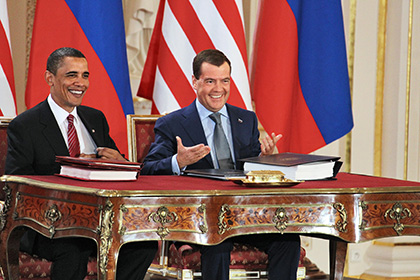12 years ago, on April 8, 2010, in Prague, presidents Barack Obama and Dmitry Medvedev signed START III. This is a key bilateral treaty regulating the strategic armaments of the two most powerful nuclear powers – the Russian Federation and the United States (officially, it is an agreement on further mutual reduction of the arsenals of deployed strategic nuclear weapons). START III entered into force on February 5, 2011 and was signed for a 10-year period with the possibility of extension for another 5 years. According to its terms, the Russian Federation and the United States were given eight years to reduce the number of nuclear warheads and their carriers to the maximum stated in the treaty:
- 700 deployed intercontinental ballistic missiles (ICBMs), deployed submarine-launched ballistic missiles (SLBMs) and deployed heavy bombers adapted for the use of nuclear weapons;
- 1,550 nuclear warheads on deployed ICBMs, deployed SLBMs and deployed heavy bombers adapted for the use of nuclear weapons (each such heavy bomber is counted as one warhead within this limitation);
- 800 deployed and non-deployed ICBM launchers, SLBM launchers and heavy bombers adapted for the use of nuclear weapons.
The Treaty consists of a preamble, 16 articles and a Protocol comprising 10 chapters.
On January 27, 2021, the parties ratified the agreement between Russia and the United States on the extension of the DSNV until February 4, 2026.
As a mechanism for verifying the implementation of the stated restrictions, the United States and Russia have agreed on the following measures:
- Inspections of the first and second types at facilities with deployed and non–deployed strategic systems (up to 18 in total per year);
- Inspections of warheads loaded on certain strategic delivery vehicles;
- Exchange of declarations on deployed strategic delivery vehicles every two years;
- Exchange of telemetry information collected during flight tests of ICBMs and SLBMs;
- Regular notifications regarding the status and basing/attachment to the facilities of all strategic delivery vehicles and launchers;
- Reporting on the availability of new types and new variants of systems accountable under the contract that are being put into service.
- Establishment of a bilateral advisory commission that meets at least twice a year;
- Advance notification of launches of ballistic missiles subject to the treaty;
- Prohibition of interference with national technical means of monitoring and verification (e.g. satellites);
- Assigning a unique identifier to each ICBM, SLBM and all heavy bombers.
You can read the full text of the agreement on our website.
What else you can read in the PIR Center on this topic:
- Strategic Offensive Reduction Treaty;
- The future of the NPT and Russia’s interests;
- Restrictions on nuclear weapons;
- U.S. Nuclear Program;
- U.S. Nuclear Forces;
- The process of the “nuclear five” 2021-2022.


